|
Across southern Louisiana these days, “laissez les bon temps rouler” could apply just as fittingly to the deepwater Gulf of Mexico, as to the annual statewide party, otherwise known as Mardi Gras. Throughout the Gulf Coast and beyond, the optimism that began to break out guardedly early last year has since erupted into a full-blown epidemic, and all the indicators suggest that “let the good times roll” will remain the tag line for some time to come.
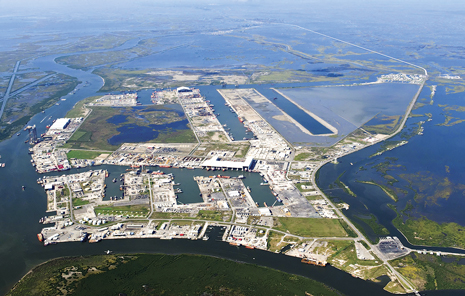 |
| Fig. 1. Over the past 53 years, Port Fourchon has grown from a largely inaccessible backwater to one of the most vital pieces of real estate in the nation. |
|
The outgrowth of a faster-than-expected resurgence in drilling and production activity is particularly evident in and around 53-year-old Port Fourchon, a once mostly inaccessible swamp now widely acknowledged as “The Gulf’s Energy Connection,” Fig. 1. It is now one of the most strategic, valuable pieces of real estate in the country. There, companies that were pulling in their reins less than three years ago are now firmly in expansion mode. They are confident that the recovery from the drilling moratorium-induced malaise is just beginning and will accelerate over the long haul. For Port Fourchon, that means waterfront properties are barely carved out of open water before companies begin stepping up, pens in hand. Chett Chiasson, the quintessential champion for all things Port Fourchon, admits that even he was caught off guard by how quickly companies jumped in line to snatch up undeveloped leases that were only recently dredged, and which may take another eight years before they are ready for full occupancy.
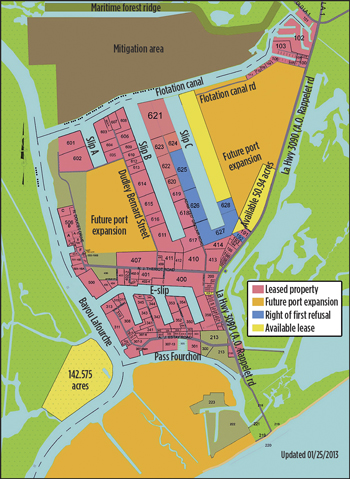 |
| Fig. 2. More than half of the recently dredged Slip C, in the northern expansion, has either been leased or is under rights of first refusal. |
|
“We certainly would not have anticipated that we already would have over half of Slip C either under lease or under rights of first refusal (Fig. 2),” said Chiasson, the port’s executive director, referring to the 400-acre work-in-progress that represents the second phase of Port Fourchon’s 13-year-old Northern Expansion campaign. “Even though leases may not be ready, companies don’t want to be left out. They’re putting their names on the dotted line, as they want to make sure space will be available for them in the future.”
Like most of their contemporaries, the Slip C opportunists see a long-lasting pump being primed throughout the Gulf. The barometer is pointed in the right direction. The year-on-year deepwater active drilling rig count continues to grow with upward of 13 additional floaters expected to join the fleet this year, inching the outer fringes of the Gulf ever closer to what one analyst predicts will be a 60-rig theater within the next two to four years. Shipyards are busier than ever, with orders for new ultra-large support vessels to replace those that left for greener pastures. And, a number of high-profile deepwater and ultra-deepwater production facilities are either scheduled for hook-up this year or are well into development.
Chiasson said the relatively swift intensification of activity in all corners of the Gulf is particularly impressive, considering that it comes in the wake of the forced hiatus that accompanied the government’s suspension of all deepwater drilling. “Compared to the activity levels we had anticipated prior to the Macondo incident, we’re basically a year late, because a lot of rigs and vessels went overseas and are staying there,” he said.
Wood Mackenzie’s Lauren Payne, Gulf analyst for upstream research, echoed the port director, suggesting in an analysis released last October that the sharp rebound is still in its embryonic stage. In the latest WoodMac upstream analysis, Payne estimated that investments in drilling and subsea production, together, would amount to $27 billion through 2015. “The moratorium, and exodus of several mobile offshore drilling units from the deepwater Gulf in 2010, sharply hindered drilling activity through 2011, but it has rebounded very well in 2012. We expect this trend to continue, driven primarily by development drilling, as operators seek to boost production levels and bring new projects on stream,” she said.
In its report, Wood Mackenzie said, despite tightening regulations, operator investments in the deepwater Gulf are expected to accelerate. “The deep-water Gulf of Mexico will remain an attractive region and will be a vibrant hub in the long term, with more than $70 billion to be spent on exploration in the region by 2030—more than all the other key deep-water provinces combined,” the firm wrote.
Meanwhile, insiders say the excruciatingly sluggish federal permitting process that followed the supposed lifting of the moratorium in October 2010 has, thankfully, been streamlined to a degree. Yet, even though the rate of drilling authorizations is starting to gather some semblance of speed, many say the increased activity levels today can be attributed largely to operators simply becoming accustomed to living with things the way they are and working within the post-Macondo regulatory framework. “Everybody is learning how to navigate through the red tape,” said Tommy Fanguy, president of independent specialty rental concern, Supreme Services & Specialty Co., of Houma, La.
Paul Danos, executive vice president of Larose, La., service and personnel contractor Danos, agrees. “Now that the new regulations have set in, people are adjusting to the new normal, and the wheels are turning again.”
BACK TO WORK
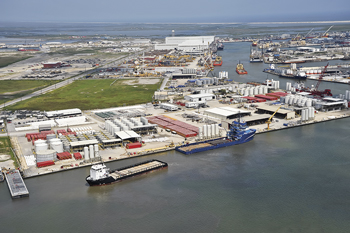 |
| Fig. 3. The Halliburton Port Fourchon base includes a 50,000-bbl plant for liquid mud and completion fluids, as well as bulk barite storage. Halliburton also has cementing operations at two separate Port Fourchon facilities. “The Port Fourchon complex supports our work in the Gulf of Mexico and is very important to our strategy, to grow our market in deep water,” said Charles Kendrick, vice president of Halliburton’s Gulf of Mexico area. “We’ve seen outstanding market growth in the Gulf of Mexico and expect that trend to continue.” |
|
The wheels and rudders are, indeed, plying Port Fourchon’s roads and waterways at a frenzied pace to service the continually growing number of rigs and production facilities at work in the Gulf. “It’s much busier this year than it was last year,” said Michael Moore, stockpoint manager for Halliburton’s Baroid division, which operates a 50,000-bbl liquid mud plant in Port Fourchon, Fig. 3. “Fourchon is really booming, and everybody’s busy right now. “
The most recent Baker Hughes tally listed 49 active rigs in both the deepwater Gulf and the Continental Shelf, representing a 20% increase over the same period in 2012. The latest numbers represent a whopping 64% increase over the same period in 2011, when only 25 rigs were working in the deep and shallow Gulf, according to Baker Hughes data.
Of those currently making hole, 26 were listed as actively drilling in deep water, out of a total fleet of 34 designated deepwater rigs. This surpasses, by one, the number of deepwater rigs available just prior to the April 2010 Macondo tragedy. By comparison, only 12 floaters were listed as active in the deepwater Gulf, a year after the deepwater and ultra-deepwater moratorium was rescinded. Lori LeBlanc, executive director of the Thibodaux, La.-based Gulf Economic Survival Team (GEST), a grassroots coalition created in June 2010 to oppose the moratorium (and later the slow pace of drilling permits), said that, by all standards of measurement, the Gulf “definitely appears to be back to work.”
“Business has really picked up,” says Wayne St. Pierre, dock manager for InterMoor Inc., whose 800-ton Cajun Lifter purportedly is the largest crane in Port Fourchon. “Right now, we’re seeing more boats moving, more rig moves, and more cranes swinging.”
“It’s definitely showing all the signs of being a great year,” added Mickey Navarro, Fourchon branch manager for Tiger Offshore. “Everybody is very busy.”
The buoyant outlook has spread beyond southern Louisiana, with New York brokerage firm International Strategy and Investment (ISI) Group going so far as to predict that the deepwater Gulf would emerge as the world’s “strongest offshore market” through mid-decade. Owing to its evaluation of discoveries and operators’ future drilling plans, the investment house forecasts 50 deepwater rigs drilling by next year, increasing to 60 or more between 2015 and 2017.
"After essentially being left for dead following the devastating Macondo blowout, the deepwater Gulf of Mexico is in the early stages of an extended growth cycle, and is poised to be the strongest offshore market in the world through 2015,” ISI veteran U.S. Gulf analyst Jud Bailey said in the analysis released in December. According to ISI, the projected increase in the rig count is fueled in part by continual development and further appraisal of the “multiple” Lower Tertiary and Miocene discoveries over the past five years.
“Most operators, especially the super majors, have aggressive plans going forward,” said Supreme Services’ Fanguy. “From what our clients tell us, 2013 is going to be a busy year. Right now, we’re seeing a lot of intervention and completion work, and they’re working over a lot of older wells. It looks like there may be a large number of recompletions over the next couple of years, as well as new drills.”
TURNING THE CORNER
Perhaps no entity operating out of Port Fourchon is more gratified by the changing fortunes than full-service logistics company Allport Services LLC. The company had a rather inauspicious beginning, having opened for business in early March 2010, a little over one month before the Deepwater Horizon blew out with tragic and lingering consequences. It was touch and go, but President and CEO Dwayne Rebstock said the Allport logistics base managed to hang in there during its infancy by assisting with the clean-up operations.
“We had no business, so that first year, we sustained ourselves with the clean-up. We did a lot of barge outfitting for housing, and that really sustained us that first year after the spill. We’ve definitely turned the corner from where we were a year ago at this time,” Rebstock said.
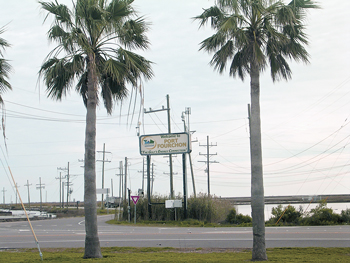 |
| Fig. 4. The sign greeting visitors illustrates the role of Port Fourchon in the Gulf of Mexico oil and gas industry. |
|
Production, likewise, is poised for a rebound, with a number of major projects set for commissioning this year. Operators are attempting to reverse an 18% decline in production that the U.S. Bureau of Ocean Energy Management (BOEM) recorded in 2011, when output fell to 1.4 million boed, a level from which it has never fully recovered. Thanks largely to the new-generation facilities (Fig. 4) planned for this year and beyond, consultancy Bentek Energy says it expects Gulf of Mexico oil production to grow nearly 28% by 2022, to 1.8 million bpd.
Chevron is at the top of the upcoming deepwater scorecard with its Jack-St. Malo semisubmersible platform in Walker Ridge, its Big Foot extended tension leg platform (ETLP), and its 42.86% interest in the Hess-operated Tubular Bells spar-based floating production system. These three projects will begin commissioning this year, with first production scheduled for 2014, in water ranging from 4,600 ft to over 7,000 ft. Elsewhere, the truss spar for Anadarko Petroleum’s Lucius development at Keathley Canyon, in 7,200 ft of water, is set to begin hook-up this year, with first production expected next year. ExxonMobil’s Hadrian project and Shell’s Olympus TLP, which will be installed this year on the Mars-B development, are also among the noteworthy production systems being readied for hook-up.
National Oilwell Varco Portable Power division, which provides energy generation for the commissioning process, is one of the local beneficiaries of the uptick caused by the new production systems streaming into the deep and ultra-deep Gulf. Ricky Adams, Gulf of Mexico sales manager, said the company has identified at least five production projects scheduled to start this year, with the possibility of eight or nine more shortly thereafter. “This year, Portable Power will have more deepwater jobs than it has ever handled at one time in the Gulf ,” he said, adding that one of those projects will be the company’s largest in the Gulf of Mexico to date.
Danos, whose namesake company has taken a right-of-first-refusal on Slip C acreage, said the dramatic increase in new production projects is aggravating a persistent shortage of skilled labor that also has accompanied the Gulf revival. “Getting personnel continues to be a major challenge,” Danos said. “We have a tremendous number of major projects coming in, that will demand more production personnel. Considering the number of production personnel that will be required to staff all these projects, we’re really on the cusp of being in a bind, if we don’t do something. Our customers are engaging with us to solve this, and have a lot of good things going on right now.”
On the farthest side of the spectrum, a smattering of companies like NOV also are finding myriad opportunities in helping operators dismantle production operations that have outlived their productive life. Portable Power, which provides power for the temporary accommodations of decommissioning crews, is among the companies gearing up to meet the expected government-imposed surge in the plug-and-abandonment (P&A) and topsides removal business.
In late 2010, the U.S. Department of the Interior (DOI) issued its so-called Idle Iron edict that gave operators a relatively short window in which to P&A wells and remove topsides, once production has ceased. The latest estimates have some 359 platforms on the Outer Continental Shelf (OCS) scheduled for removal this year, out of 813 inactive structures slated for deletion. Most analysts doubt, however, that the capacity is there for all 359 non-productive units to be removed this year.
Meanwhile, BOEM, the federal agency responsible for managing all OCS E&P activities, held its second-consecutive Central Gulf of Mexico lease offering (lease sale 227) on March 20 that included some 7,250 blocks covering 38 million acres, in water depths up to 11,115 ft. Federal lease sale 227 followed on the heels of a similar Central Gulf offering last June that drew 593 bids on 454 tracts covering more than 2.4 million acres.
Chiasson said, with operators opening their checkbooks to take advantage of the re-started federal leasing program, there should be no doubt as to the long-term vitality of the deepwater Gulf of Mexico. “We look at the lease sales as longevity. Companies are looking at the activity now, and what they see coming up, and they know they’re going to need more room,” he said.
EXPANSION ON TRACK
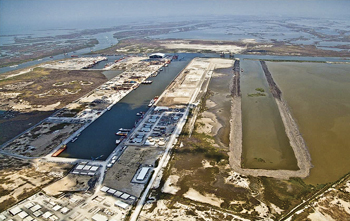 |
| Fig. 5. Slip C takes shape after being dredged from what was once open water. |
|
Provision of that additional space is the impetus behind the ongoing 800-acre Northern Expansion project that the governing Greater Lafourche Port Commission authorized in 2000. This work has advanced steadily, leading to the recent hydraulic dredging of Slip C, Fig. 5. The first phase of the aggressive expansion program comprised dredging and bulkhead construction of Slips A and B, both of which are completely leased, Chiasson said.
Once fully developed, the new Slip C will provide 16,300 linear ft of waterfront space, and when the adjacent property is filled and developed, up to 280 acres will be available for leasing. Chiasson said the port originally assumed that the complete build-out of Slip C could take up to 12 years, but with the interest from both existing and new tenants, that projected timeline is in for a major modification downward. Port Fourchon presently provides occupancy for 80 tenants on 130 total leases.
“If what we are seeing now is any indication, what we anticipated to be a 10-to-12-year build-out of Slip C will be cut in half,” he said. “We will probably see Slip C, at least from the lease front, be completely leased out within the next five to six years. The industry is picking up, and the deepwater demand is certainly there.”
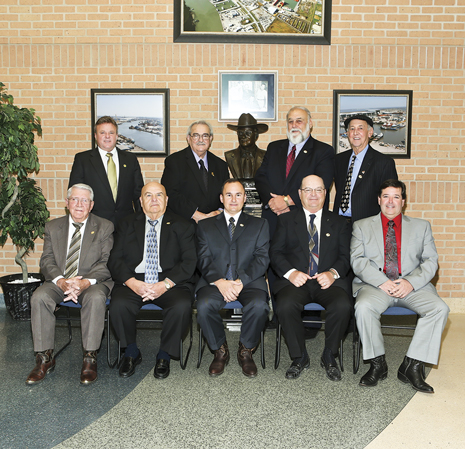 |
| Fig. 6. The newly inaugurated 2013 Greater Lafourche Port Commission board of directors include, from left, Chuckie Cheramie, Perry Gisclair, Kris Gaudet, Donald Vizier, Wilbert Collins, Larry Griffin, John Melancon, Jr., Jimmy Guidry and Ervin Bruce. |
|
Chiasson was not the only port official surprised at the immediate rush to grab up yet-to-be-developed Slip C property. “People believe in our port and the way we do business,” said Larry Griffin, one of the port commission’s nine board members, Fig. 6. “We’re leasing out property faster than we can build it. It’s amazing to see the port grow before our eyes.”
Giant Edison Chouest Offshore of Galliano, La.; Bollinger Shipyards of Lockport, La.; and Harvey Gulf International Marine of New Orleans were among the first firms to grab up undeveloped Slip C property. Chouest, which holds two leases encompassing 90 cumulative acres, plans to erect its third covered C-Port at the head of Slip C.
While Chouest plans to self-build its Slip C bulkhead, Chiasson said the design phase is now underway, with bids to be opened in May and construction of the remaining bulkheads expected to begin this summer. If all goes as scheduled, the Slip C bulkheads should be completed by mid-2014, he said. “Everything that has a bulkhead today is leased, and we certainly have no shortage of people wanting space,” Chiasson said.
Accompanying the deepwater rigs currently drilling, and the ones expected to join the fleet beginning this year, is a continually growing flotilla of 240-ft-plus service and supply vessels. While docks are being constructed, Chiasson said the port has erected 18 mooring dolphins and plans to install more to handle the current and future overflow. “It gives the vessel operators a place to tie up while they’re waiting for dock space to open. Basically, it’s on a first-come, first-served basis, but the first nine we built were leased out long-term,” he said. “The problem is, there’s only so many of those we can put in.”
Chiasson said port officials are in preliminary talks with vessel operators and other tenants to head off what could develop into the marine equivalent of a major traffic jam. “The vessel traffic is growing constantly and will only get bigger. We’ve been very fortunate that the vessel operators and the captains do a wonderful job, and we’ve had few issues as far as traffic is concerned.”
“However, operators are going out to deeper waters, which will require more and even bigger vessels, so we’re in discussions to see what type of traffic system we may need to implement, just to keep the safety factor where it needs to be. We’re talking with the vessel operators and our tenants, because we want to make sure we give them something they want and need, and something that will not increase their costs or cause any hassles,” he said.
In a related development, the port commission also oversees the nearby South Lafourche Leonard Miller Jr. Airport, which also recently completed a major expansion and, likewise, has no shortage of business from both helicopter and corporate jet pilots. “Between 2011 and 2012, we had a 41% increase in airport operations, which includes take-offs and landings, and we anticipate the same or more this year,” Chiasson said.
The airport recently completed a $4.5-million 6,500-ft parallel taxiway, which was wholly funded by the U.S. Federal Aviation Administration (FAA). The taxiway cleared the way for the installation of a full instrument landing system, that Chiasson said is critical to increasing both the reliability and utilization of any airport. “We also built two new hangars last year, and hopefully next year we will build a new terminal,” he said.
To a person, the good times are most definitely rolling, with expectations that they will continue doing just that for at least the foreseeable future. “We’re very bullish about what we’re seeing,” Danos said. “We’re really excited about what we see in the Gulf of Mexico and the projects coming in, and all that activity will drive right through Port Fourchon.” 
|
BOLLINGER INCREASES FOOTPRINT IN PORT
Already among the largest marine construction and repair companies on the Gulf Coast, Bollinger Shipyards of Lockport, La., was one of the first to put its name on a Slip C lease, deciding the time was definitely right to beef up its presence in the Port Fourchon area.
Ben Bordelon, executive vice president of repair for the 67-year-old family-owned shipyard, said the newly acquired property, which includes “the whole back of Slip C to the bottom of the ‘U,’” will provide 2,100 ft of bulkhead once completely developed. The roughly 46-acre site will house a full-service lay down facility that will include fabrication capabilities, three dry docks, housing, machine shops and offices, as well as cranes and other support equipment. As plans now stand, Bordelon said the yard could be up and running by May or June 2014.
He said the decision to invest in a new Port Fourchon yard was fueled in part by the more than 70 vessels, of 3,000 dwt or greater, planned for construction at U.S. shipyards. “With all these new and much larger vessels being built, with the new drillships coming in, and the increased level of subsea activity, we certainly don’t see demand backing down. We listened to our clients’ needs, and that’s why we took a proactive approach and decided we needed a larger footprint in Fourchon,” Bordelon said.
Bollinger will continue to operate its long-established repair facility on Bayou Lafourche, but will relocate its two dry docks to Port Fourchon, once the new Slip C yard is completed. Joining them will be a new 10,000-ton drydock scheduled to arrive in Port Fourchon in November, to wait out the development of the new facility. Bordelon said it was a tremendous commitment, but one justified by the level of near-term and future activity that Bollinger expects from throughout the Gulf.
“This is a big commitment for us, because as everyone knows, Fourchon is not a cheap ballgame to play in. It literally requires building a shipyard and all the facilities from marshes,” he said. “But, we see the commitment by the majors and the independents, and the optimism is very strong, so we responded to what we see as a great opportunity.” 
|
|
DEEPWATER GETS THE INK, BUT DON’T COUNT OUT THE SHELF
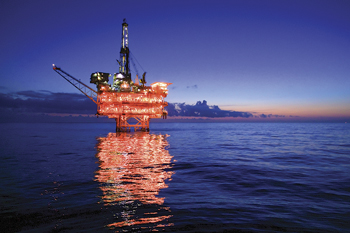 |
| One of the near-shore platforms that contributed to a 7% increase in Apache’s Gulf of Mexico shelf production during fourth-quarter 2012. (Photo courtesy of Apache Corp.) |
|
While Port Fourchon is more closely aligned with the deep and ultra-deepwater Gulf, players on the shelf are also contributing significantly to increased activity.
Despite today’s low, albeit rising, gas prices, New Orleans’ McMoRan Exploration Co, Energy XXI, Apache and others continue to construct wells that are 20,000 ft and deeper along the Gulf of Mexico shelf. Apache, for instance, operated five shallow-water rigs during the fourth quarter and saw its shelf production reach 95,980 boed, representing a 7% quarter-over-quarter increase. Apache was awarded 60 of the 66 blocks that it bid on in the June 2012 Central Gulf of Mexico Lease Sale, and now has an interest in 666 blocks covering approximately 3 million gross acres on the shelf, the operator said.
Today’s shelf activity is quite a reversal for a drilling theater that essentially was left for dead four years ago. Most observers credit McMoRan, which remains the shelf’s most active player, with bringing new life to it, with its 2010 Davy Jones discovery drilled to a blistering 29,000-ft TD.
“Of the six rigs we service out of here, three are drilling on the shelf,” said Port Fourchon tenant Dwayne Rebstock, president and CEO of Allport Services LLC. “It was really drying up between 2008 and 2009, but now companies are re-drilling and re-entering old wells. The shelf really hasn’t died off at all.”
Illustrating the shelf’s new life is the number of once-stacked jackups that are now being refurbished, allowing them to return to service. Ben Bordelon, executive vice president of repair for giant Bollinger Shipyards of Lockport, La., said in late January that the company had overhauled three stacked jackups over the previous two quarters, with four more tentatively scheduled over the subsequent two quarters.
“The shelf has struggled, but we began seeing an uptick in activity last year. There’s so much optimism there, for sure, and it’s encouraging to finally have a good heartbeat in that market,” Bordelon said.
Tommy Fanguy, president of Houma’s Supreme Services & Specialty Co., suggested that the shelf would be an ideal proving ground for any company wanting to field-trial the very latest in high-pressure, high-temperature (HPHT) technology. “Between extremely high pressures and temperatures, the shelf definitely poses a lot of challenges. Most of the work there now is workovers and P&A, but there’s some potential for new development, if the high-temperature and high-pressure stuff takes off,” he said.
Newpark Drilling Fluids, which has long held a prominent position on the shelf, was reminded of those challenges with a recent 25,000-ft TD well drilled off the shelf in 85 ft of water. Newpark’s South Louisiana regional operations manager, Sam Smith, said the well generated bottomhole circulating temperatures (BHT) of 365°F, with pressures requiring a surface mud weight of 19 lb/gal.
“We had to determine the equivalent mud weight for both getting in and out of the hole. We definitely ran a lot of laboratory tests for this well and, overall, it was a very well-managed operation.”
Smith said the ultra-deep HPHT wells that characterize shelf targets are not the place for drilling fluid engineers to learn on the job. “Our mud engineers for this well averaged 15 years of experience,” he said. “For these ultra-deep wells, once you get past 25,000 ft, you're playing in an entirely different environment.”
The 400-day well, which reached its targeted depth early this year, required mixing more than 50,000 bbl of oil-based mud, which was run on a closed loop drilling system. “We had some folks working overtime.”
Newpark operates two yards in Port Fourchon with a cumulative capacity of 40,000 bbl of water, oil and synthetic-based drilling fluids. 
|
|
NOV LENDS HAND IN NY STORM RECOVERY
|
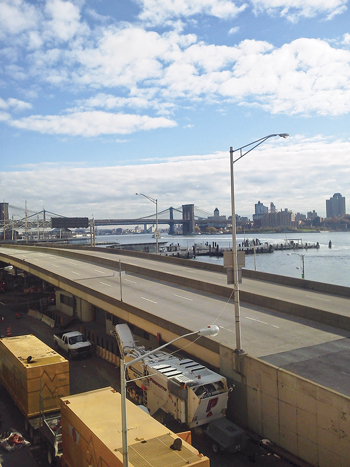
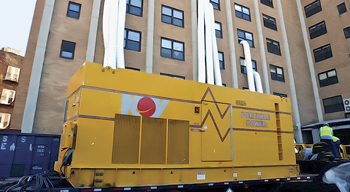
|
| One of the near-shore platforms that contributed to a 7% increase in Apache’s Gulf of Mexico shelf production during fourth-quarter 2012. (Photo courtesy of Apache Corp.) |
|
Folks in South Louisiana know a thing or two about coping with hurricanes, so when Hurricane Sandy atypically smashed into the U.S. northeastern coast last November, a group from the NOV Portable Power division marshaled its expertise and headed to New York.
Personnel from the company’s Larose, La., operations joined colleagues from across the country to help in the immediate recovery efforts. With electrical power all but non-existent throughout the hardest-hit areas, NOV Portable Power generators were used in myriad recovery applications at hotels, along Wall Street, in subway stations, and at the Conoco refinery, and were even used to help power voting booths for the U.S. presidential election. 
|
|











